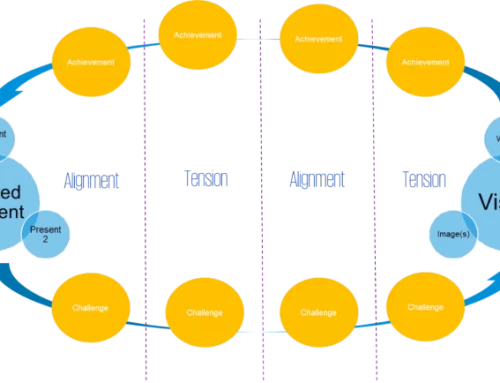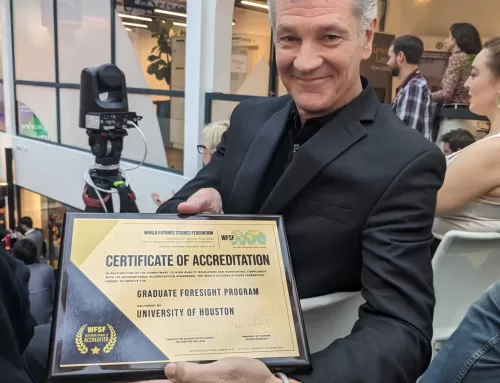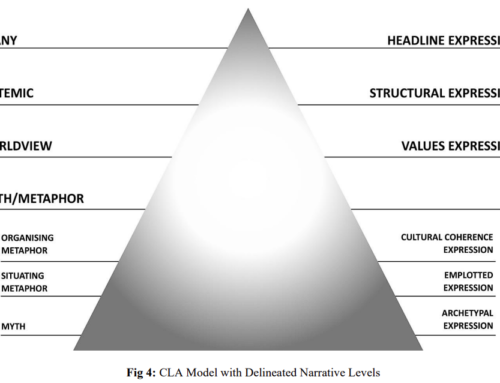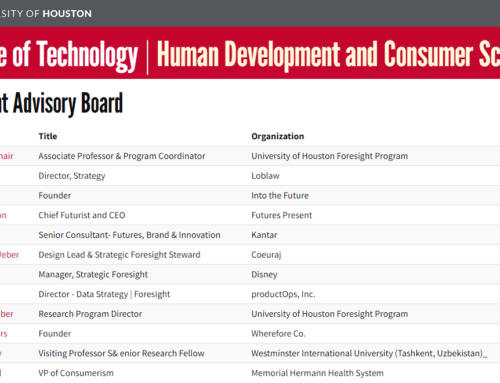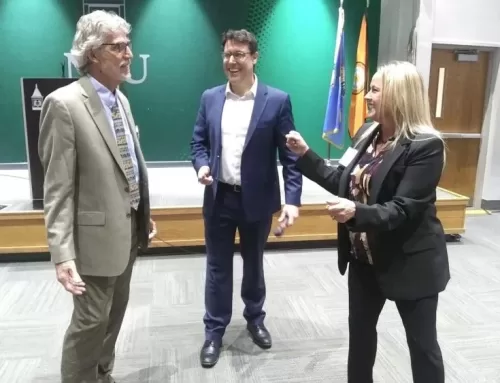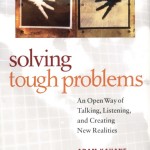
Solving Tough Problems is about conflict resolution, communication, and using scenarios to think about the future. Although it’s marketed as a business book, the material is applicable globally to all individuals and all sectors of society. Decision-makers, policy makers and those who seek to influence the same are the most likely audience of readers who would find the book most appealing. However, the book provides case study stories and insights that are immediately applicable for parents, students, mediators, counselors, educators and all who are open to extending their communication skills in a much wider and more inclusive direction.
The title initially attracted me to the book but it was the intriguing foreword by Peter Senge and the noted comments from over 20 individuals (including Nelson Mandela) praising Mr. Kahane that converted my attraction to a reading intention. I wondered if this book might offer a different perspective on the value of scenario planning itself, rather than on the steps or processes involved in constructing actual scenarios themselves, much like the descriptions of the other books on my reading list seemed to indicate. Approximately twenty pages of reading confirmed my impression that the contents were not about how to go about resolving conflict or structuring complex negotiations. Refreshingly, the author describes an approach to go about adopting a mental model that when practiced creates a new “openness” – a mindset which he explains is not only more personally rewarding but has longer-lasting benefits for everyone involved in the opening process.
Mr. Kahane writes with a compelling desire to share what he has learned from his years of experience as a facilitator working to help groups get un-stuck from their complex problems. From his own experiences, he offers a review of what has observed to work well, and what hasn’t worked well. He certainly has an extensive background from which to draw upon a set of unique experiences. His transformational journey from “searching for the one right answer” as a rational economist and then later as a policy analyst at Pacific Gas and Electric to a scenario provoking forecaster at Royal Dutch Shell chronicles a growing realization that there may be several “right answers”, depending upon how you look at the problem that you are trying to solve.
His work at Royal Dutch Shell is clearly the most formative period for Kahane as he fondly and proudly writes about his exposure to the thought leadership of Kees van der Heijeden (who himself worked for the Pierre Wack, a leading pioneer in scenario development) and his boss Joseph Jaworski. With still somewhat of an astonished amazement some 15 years later, Kahane tells about how it came to be in 1991 when Jaworski asked him to organize a scenario project for activists in South Africa. This pivotal experience changed his life as he witnessed and helped to facilitate an extraordinary new reality creation process. How the participants who were involved in the process went about their work and why they were so successful fascinates him for years. Kahane becomes determined to see if the talking and listening approach he witnessed in the development of the Mont Fleur Scenarios (http://www.montfleur.co.za/) can be replicated in other tough, complex problem solving environments.
Almost autobiographical, Kahane goes on to narrate a series of personal stories and examines them as case studies drawn from his own experiences over the years. His style is non-technical; it is very approachable and often very touching. He repeatedly yet gently emphasizes the benefits of his learned communications outcome after each story or vignette. He often notes the mistakes or gaffes that he made or the assumptions that he had which led to him getting stuck in non-listening modes. As well, he offers practical concepts for the reader to consider in a variety of conversational situations. These stories flow well together and offer a rare behind the scenes look at how some famous and well-known societies from around the world came closer to creating new realities, or stayed stuck in their perceived reality, depending upon how the participants chose to view themselves as part or apart of the problem.
Through the telling of his involvement in talks with the South African Mont Fleur participants, The Basques, Irish Nationalists, and Guatemalan citizens searching for peaceful solutions, Kahane sees that tough problems usually don’t get solved peacefully, or they don’t get solved at all. He explains that talking and listening can help solve problems, but that often is too hard and takes too long. He realizes that for many, talking often means “telling” and “listening” often means listening to ourselves talk. This is fine for simple problems, but not for complex problems. Complex programs requires relational listening – not the more tactical kind of listening of which we are accustomed.
Kahane observes that problems are tough in three ways:
They can be dynamically complex where cause and effect are far apart in space and time and therefore hard to grasp in firsthand experience.
They can be generatively complex in that the problem unfolds in unfamiliar and unpredictable ways.
They can also be socially complex when people see the problem in very different ways, which can lead to a feeling of being stuck in how to solve the problem.
He realizes that “A complex problem can only be solved peacefully if the people who are part of the problem work together to creatively understand their situation and to improve it”. It occurs to him that people everywhere are struggling to overcome their own “apartheids” – their apartness. Kahane asserts that it is only when everyone opens up, by listening and talking in new ways, will we find our better selves enabled to help better futures to be born.
This then is the main idea or theme of the book: we are unable to productively talk about problems because we are unable to listen. If we change the way we listen and talk, we can create (act) on contributing to meaningful change. Seeing yourself as part of the problem, rather than “apart” from the problem is the key. Scenarios can help you see this. Once you see it, then you are pursuing “an open way” – a way of opened hearts and minds that were previously closed.
For me, Kahane’s unique take on the power of scenarios adds a philosophical element that I had not expected. His use of scenarios in South Africa demonstrated what can happen when reality is taken in (“breathing in” as he calls it), from multiple perspectives. Participants in the Mont Fleur scenario workshops came to realize that more than one future was possible; they believed that they could actively shape their future and that while it could not be predicted, it could be influenced. Kahane himself had not fully experienced or appreciated this kind of liberating scenario power until he left Royal Dutch Shell to work on the Mont Fleur Scenario Project in South Africa. At Shell, his scenarios were about forecasting. In South Africa, the scenario work included forecasting but went on to create new realities. But the thing is that new realities aren’t possible until everyone’s communication changes.
After reading and thinking about his book and the power of scenarios, I find myself now really trying to listen – not at just what I’m hearing, but listening to the situation of the person from which the words are being spoken. I am also now more quickly able to realize when I’m not really listening, even when I thought that I was listening. And, I’m also now able to spot others who are doing more talking rather than listening.
But Mr. Kahane also reminds us that in order to solve tough problems peacefully, we also must be able to speak openly. “When someone speaks personally, passionately, and from the heart, the conversation deepens.” He encourages all actors in the system to speak up. “Politeness maintains the status quo!” When we see that the status quo isn’t working, we must speak up.
I admit that at first, I thought these concepts seemed fairly simple and obvious. I wasn’t sure how a whole book could interestingly expand on the idea of just talking and listening with more authentic intent. But as I read more I was drawn in further and started to imagine how the concepts could work if I were in the same situation. I also found myself recalling situations from my personal and work life where taking the author’s advice would have resulted in better outcomes.
Solving Tough Problems clearly achieves its goal of describing, encouraging, and advocating for “a way” that will make a difference in our lives. It seems to be Kahane’s hope that his experience at Mont Fleur and elsewhere will contagiously spread and serve as an inspiration to others. I think Kahane sees himself as such an agent – a carrier of open talking, listening, thinking, learning, and action, which is no doubt why he wrote this book and to this day continues his work in this area. I’m very glad to have read this book in my own formative stages of learning about futures studies. I would certainly recommend this book to others, especially my colleagues at the UH, because this book demonstrates the value in how scenarios conducted in a style of open communication can really bring people together and stimulate real change.
By Timothy Mitchell, Houston Futures
